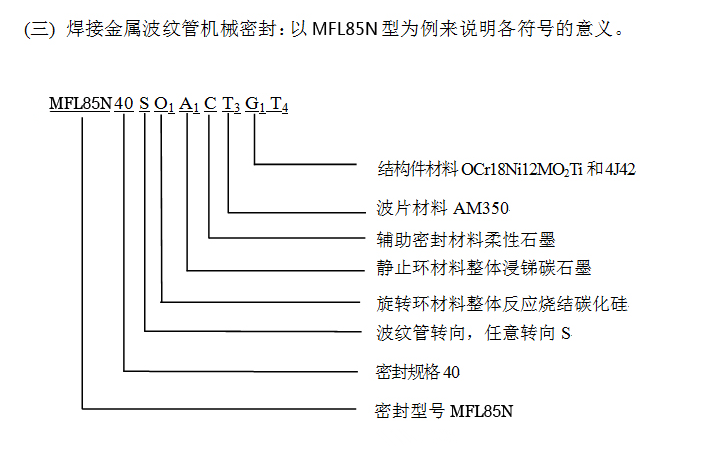Technical selection
Selection principle of model
Selection principle of mechanical seal:
The type selection of mechanical seal is a complicated system engineering, which requires comprehensive analysis of various process parameters to select an appropriate seal structure type. The following comments are for reference:
(I) Seal cavity pressure
For the medium with good lubricity and high viscosity, balanced seal should be selected when ≥0.8MPa, and unbalanced seal should be selected on the contrary; For the medium with poor lubricity and low viscosity, balanced seal shall be selected when ≥0.5MPa, and unbalanced seal shall be selected on the contrary; For light hydrocarbon medium, no matter how high the pressure of sealing cavity is, balanced seal shall be selected. For medium with particularly high pressure, such as: 5~6MPa above the selection of multi-stage seal.
For metal bellows seal, if the pressure of seal cavity is greater than 2MPa, double-layer bellows shall be selected; otherwise, single-layer bellows shall be selected.
(II) Linear velocity of friction pair
When the linear velocity of friction pair is ≥25m/s, static seal shall be selected.
The linear velocity of friction pair is less than 25m/s, and rotary seal is selected.
(III) Medium temperature in sealing cavity
1. Determine the structure and material of auxiliary seal, the service temperature of nitrile rubber is -40~120℃, ethylene propylene rubber ≤-57~150℃, fluorine rubber -34~204℃, polytetrafluoroethylene ~250℃, perfluoroether rubber ≥260℃.
2. Determine the sealing system scheme according to the medium temperature.
3. Austenitic stainless steel inlaid hard alloy ring or SiC ring can only be used below 100℃, titanium alloy inlaid hard alloy ring or SiC ring can be used below 150~200℃, otherwise only low expansion alloy 4J42 can be used to inlay alloy or SiC ring, or adopt integral hard alloy ring or integral SiC ring.
4. If the temperature of seal cavity is ≥200℃, welded metal bellows mechanical seal shall be selected in principle.
(IV) Influence of effective space of sealing cavity:
the radial dimension of the sealing cavity is smaller, the axial dimension is larger, and a single spring structure can be selected; The radial dimension is larger, but the axial dimension is smaller, so a multi-spring structure can be selected, and the axial dimension of the seal can be shortest by adopting a wave spring.
(V) Influence of medium characteristics:
1. Viscosity: For medium with low viscosity, balanced seal is mostly selected; High viscosity medium, seal transmission to be reliable, can choose fork transmission or key transmission, seal can also choose "knife edge" type seal.
2. Medium corrosion degree: In addition to the required sealing materials, it also involves the sealing structure form. For example, for strong corrosive media such as sparse acid or hydrochloric acid, the material of metal bellows shall be Hashimoto C or Hashimoto B. For spring-type seal, the externally installed PTFE bellows structure can be selected.
3. Whether there are solid particles in the medium: For the medium containing solid particles, the friction pair materials shall be YG6/YG8 or YG6/SiC,SiC/SiC, hard-to-hard materials.
4. For toxic, flammable, explosive and valuable materials, double-end mechanical seal shall be selected.
(VI) Influence of shaft diameter:
Single spring type seal is generally used in the case of small shaft diameter. For the seal with large shaft diameter, multi-spring structure is generally selected, because the elastic force of multi-spring structure on the sealing surface is uniform.
(VII) Mechanical seal type selection table:
Description of mechanical seal selection table:
Column 1, medium name: refers to the chemical name or trade name of the sealed medium in the pump.
Column 2, concentration: refers to the concentration of the sealed medium in the pump, or the percentage of each component in case of mixture.
Column 3, Temperature: refers to the actual temperature in the sealed chamber.
Column 4, melting point: refers to the freezing point (freezing temperature) obtained by liquid-solid conversion of the sealed medium and the melting point obtained by solid-liquid conversion. If there is a difference between the two, the highest temperature shall be taken as the melting point of the medium.
Column 5, Boiling point: Boiling point of the medium at atmospheric pressure (1.013 bar).
Column 6, Sealing: refers to the density of the medium at 20℃, g/cm3. The gas density is the relative density of air.
Column 7, State of the medium: means the physical state of the medium at 20℃ and 1.013 bar, Q-gaseous state, Y-liquid state, G-solid state, J-crystalline, N-viscous liquid.
Column 8, sealing arrangement: S-single end face sealing structure, D1-back-to-back type, axial double end face sealing structure, D2-tandem type, axial double end face sealing structure.
Column 9, Seal Type
1-the shaft assist seal is a rubber O-ring built-in spr type mechanical seal
2-the shaft-assisted seal is a polytetrafluoroethylene V-shaped ring or a wedge-shaped ring built-in spring type mechanical seal,
3-an externally mounted spring type mechanical seal,
4-Metal bellows type mechanical seal.
Column 10, sealing surface material: refer to the code table of mechanical sealing material.
Column 11, Hazard prompt: D1-Medium is moderately toxic, D2-Medium is highly toxic, F1-Weak corrosive, F2-Flammable, medium may be ignited or burned, R2-Flammable, medium has low ignition point and is easy to cause combustion reaction under heating, impact and friction, R3-Natural, B-Explosive, medium is easy to cause explosion under heating, strong light irradiation, impact and friction, Y1-Weak oxidizing, Y2-Strong oxidizing, S1-Decomposition under moisture, S2-Reaction under moisture.
Column 12, Rinse Regimen: 1. No Rinse; 2, self-flushing;3, external flushing; 4. Circulation of spacer fluid.
.png)

Model Selection Data Sheet of Mechanical Seals
.png)



